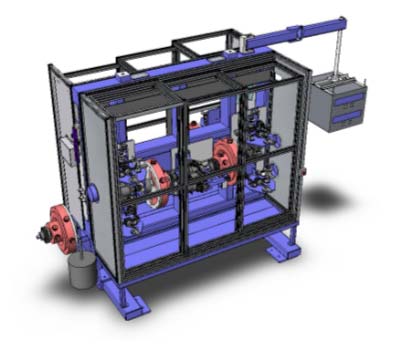The purpose of this test rig was to provide
the required testing facility for the ARC
system during its development and before its
validation in an upwards / downwards
traveling elevator car, which represented a
much more expensive experimentation phase.
The ARC system to be tested is mounted on a
complete high-rise high-speed elevator car
suspended in the test rig. The out of
straightness and the bumpiness of the guide
rails, which are, beside air gusts, the
major source of vibrations in the elevator
car, are emulated using 8 hydraulic
cylinders, so that no vertical travel of the
elevator car is needed. To validate the
effectiveness of the ARC system, the exact
rail profiles were measured in a typical
representative elevator shaft and then
generated in real time using a hydraulic
excitation system at different travel
speeds, having in each case the same
frequency content as in real vertical
travel.
Some of the jobs needed to engineer, build
and program the test rig were as follows:
-
Engineering studies to determine the
specifications of the hydraulic
excitation system, such as the required
accuracy and repeatability of the
cylinder position, the needed system
dynamic (frequency response of the
cylinder position) and the stiffness of
the cylinder. The starting point to
determine these specifications was the
additional requirement that the rail
profile may be identified during a
“learning travel” of the elevator car,
so that the identified rail profile will
be used in the vibrations damping during
the following travels.
-
Produce the terms of reference for the
development of the control system
responsible for the position control of
the hydraulic excitation system. This
system is composed of a VME based
real-time computer generating the
command signals to the driver boards of
the hydraulic cylinders so that the
position trajectory for each cylinder is
correctly followed (each hydraulic
cylinder produces linear motion as
commanded by a servo valve operated by a
stepper motor driven by a corresponding
driver board). The same real-time
computer is also responsible for the
global system monitoring and safety.
-
Design and construction of the elevator
car suspension frame, where the complete
elevator car, the ARC system and the
hydraulic excitation system are all
mounted (total weight about 4’000 kg,
height 6.5m).
-
System integration and validation in
cooperation with the various subsystems’
suppliers.
-
Programming of the rail profiles to
emulate the vibrations during elevator
travel at different speeds and at
various single frequencies.
The test rig for ARC is currently of
valuable use to further develop and test ARC
systems before their installations into
actual traveling elevators and also to
optimize the conventional passive vibration
damping systems.
